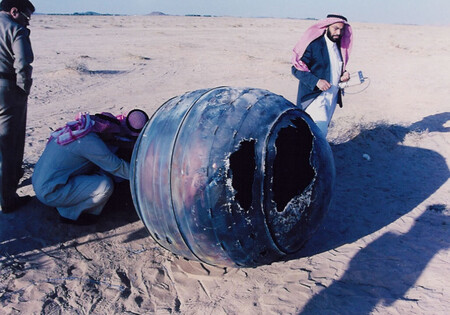Space agencies and companies are launching more rockets into space than ever before. With entities such as SpaceX and countries like China, rocket launches currently occur every few days. This marks a new space race with multiple objectives on the horizon. The increased activity is making space transportation cheaper. However, it’s also creating a new problem: the growing amount of space junk orbiting our planet.
This situation leads to another concern. As more satellites and rockets populate Earth’s orbit, the risk of collision between space junk and aircraft is increasing. Researchers at the University of British Columbia have been analyzing this issue. Unsurprisingly, they’ve concluded that the consequences of a collision would be catastrophic.
The issue. Beyond testing rockets and transporting goods or people, one primary driver of these launches is the deployment of satellites that provide Internet connectivity worldwide. While several companies operate in this sector, SpaceX is currently leading the charge with its Starlink program. The company sends these satellites into orbit using rockets that descend back to Earth after completing their missions.
Some of these rockets partially disintegrate upon reentry, while others fall uncontrollably back to the ground. The ocean is often the main landing area. However, there’s also a risk that they could land in urban areas or collide with an aircraft during their descent.
The probability. First and foremost, it’s important to ensure peace of mind. The risk of space junk hitting an aircraft is low–very low. According to The Aerospace Corporation, during a period of heightened rocket launches in 2021, the risk was estimated at one in 100,000 (0.001%). Projections indicate that this probability could increase to seven in 10,000 (0.07%) by 2035.
Although this is a low probability, it does exist. The Canadian study analyzed how these risks correlate with air traffic density. For example, taking into account flight traffic from Sept. 1, 2023 in the U.S., researchers found that each year, there’s a 99% probability of rocket debris reentries occurring in the green areas on the map below. The probability decreases to 75% in yellow areas, 26% in orange areas, and 0.8% in red areas.
The red areas represent the busiest regions, typically around major airports, while the orange areas are major cities. Meanwhile, the yellow and green areas are located farther from urban centers and, as such, experience less aircraft congestion.

Long March 5B. Beyond the extremely low probability of direct collisions with aircraft, another concern is the potential necessity to close airspace due to space junk. For instance, on Nov. 4, 2022, the 20-ton body of the Long March 5B rocket reentered the atmosphere and fell over the Pacific Ocean.
While this incident had a safe outcome, it could’ve been far more dangerous. The location of its reentry was purely a matter of chance. The rocket body was left in orbit without a planned design for its reentry, highlighting the unpredictability associated with space junk.
Consequences. The night before the rocket’s reentry, several surveillance agencies and the European Union Aviation Safety Agency issued reports advising national authorities to restrict airspace within a corridor of at least 45 to 75 miles on either side of the estimated reentry trajectory.
In response, both Spanish and French authorities closed portions of their airspace. This decision delayed 645 flights, with an average delay of 29 minutes per plane. Additionally, some flights already in the air were required to either return to their departure airport or take a detour. This situation highlighted a lack of planning, anticipation, and control over the issue of space junk.
Interestingly, Portugal, Italy, and Greece chose not to close their airspace, which created further complications at their airports due to an unexpected increase in air traffic from diverted flights.
 In purple, the airspace closed due to the Long March 5B rocket. In blue, its trajectory and fall are indicated.
In purple, the airspace closed due to the Long March 5B rocket. In blue, its trajectory and fall are indicated.
Solutions. Unfortunately, while the issue of space junk will continue to grow, there’s currently no immediate solution for controlling its reentry. Researchers suggest that rocket launch companies should invest in controllable reentry technologies to prevent space junk from entering the atmosphere unpredictably.
These technologies include engines capable of reigniting to help steer the rocket during descent. They also include improved mission planning to ensure rockets land in remote areas of the ocean, away from populated regions and air traffic. The problem is that, despite the existence of these technologies, less than 35% of launches currently use controlled reentries. With around 2,300 objects in orbit and an annual increase of 30 to 40 new bodies, the risks will continue to rise.
 In 2001, the titanium engine cover of the third stage of a Delta 2 rocket, weighing around 70 kg, landed in Saudi Arabia, about 150 miles from the capital city.
In 2001, the titanium engine cover of the third stage of a Delta 2 rocket, weighing around 70 kg, landed in Saudi Arabia, about 150 miles from the capital city.
The current approach is a significant waste of money. This is why achievements such as SpaceX’s ability to catch the Starship booster and the engineers’ advancements in reusing rockets are crucial. Additionally, there needs to be a global protocol for managing these reentries and making coordinated decisions rather than leaving everything to an unaccountable aerospace industry.
In the end, it’s more likely that air traffic disruptions will occur due to space junk rather than a collision between debris and an aircraft. However, since the probability of these collisions isn’t zero, it’s essential to consider potential solutions to address this issue.
Image | SpaceX



Log in to leave a comment